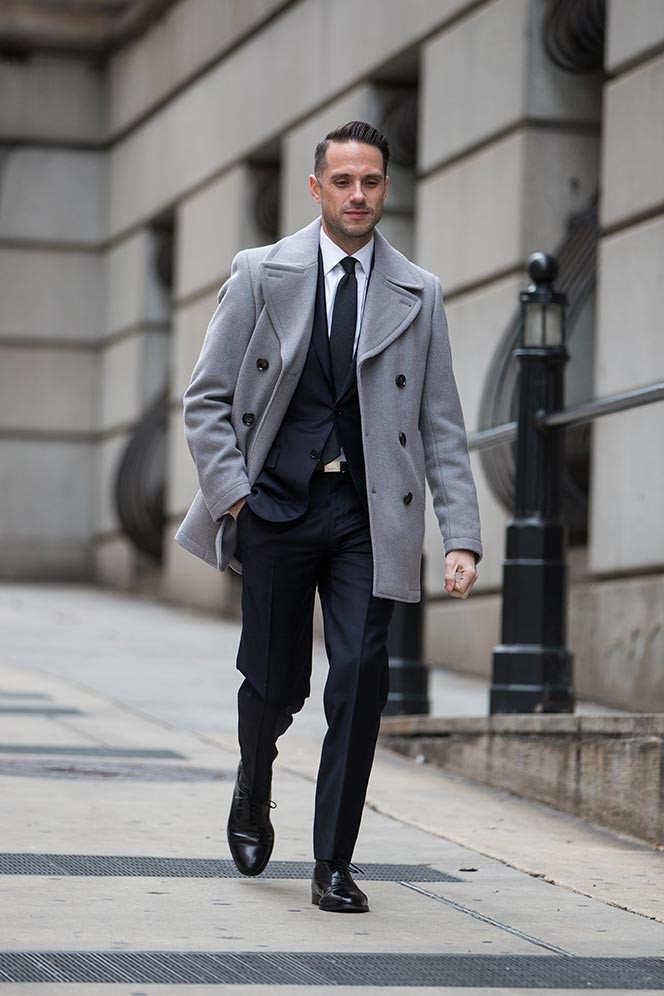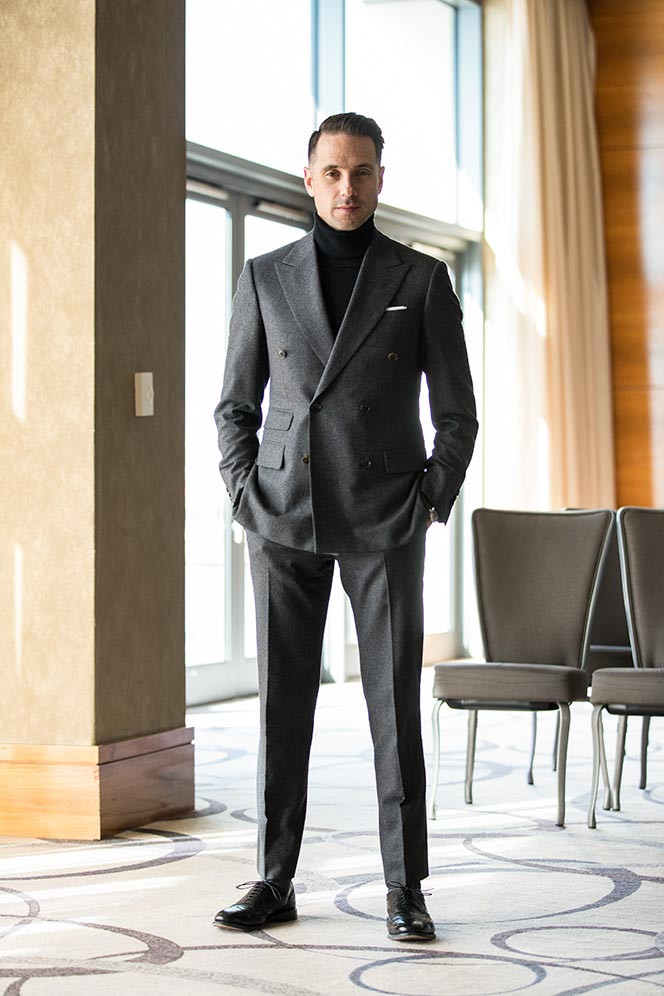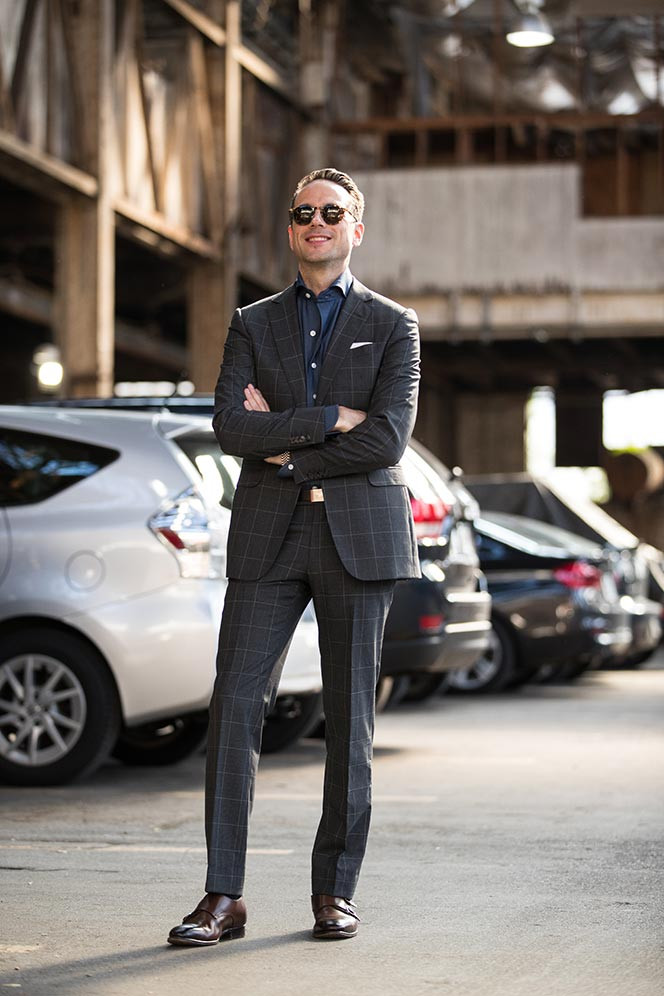How Many Suits Does A Lawyer Need to maintain a professional and versatile wardrobe? A lawyer’s suit collection is a crucial aspect of their professional image, and at internetlawyers.net, we understand the importance of dressing for success in the legal field, that’s why we recommend having a minimum of five suits that can be mixed and matched for various occasions. Investing in a curated suit wardrobe ensures that you’re always appropriately dressed, projecting confidence and competence, ultimately, contributing to your professional success with attorney outfits and legal attire.
1. Understanding the Professional Landscape
In the legal profession, first impressions matter. Your attire speaks volumes before you even utter a word. Lawyers are expected to maintain a polished and professional appearance, conveying credibility, competence, and attention to detail. The right suit can instill confidence in clients, impress judges, and command respect from peers.
1.1. The Importance of Professional Appearance
A well-tailored suit is more than just clothing; it’s a symbol of professionalism and authority. Studies have shown that people are more likely to trust and respect individuals who dress professionally. For lawyers, this trust is essential for building client relationships and winning cases.
- Client Confidence: Clients want to feel confident that their lawyer is capable and trustworthy. A sharp suit can project an image of success and competence.
- Courtroom Presence: In the courtroom, a lawyer’s appearance can influence the judge and jury. A well-dressed lawyer commands attention and respect.
- Peer Perception: Among colleagues, a professional appearance can enhance your reputation and open doors to networking and collaboration opportunities.
1.2. Factors Influencing Suit Requirements
The number of suits a lawyer needs depends on several factors, including:
- Practice Area: Lawyers in corporate law or litigation may need more suits than those in less formal areas like mediation or academia.
- Work Environment: Law firms vary in their dress code policies. Some firms require suits daily, while others allow for business casual attire.
- Client Interaction: Lawyers who frequently meet with clients need a more extensive suit wardrobe than those who primarily work behind the scenes.
- Personal Preference: Some lawyers enjoy dressing up and prefer to have a wide variety of suits, while others prefer a more minimalist approach.
- Frequency of Wear: The more often you wear a suit, the more suits you’ll need to avoid wearing the same suit too frequently, which can lead to faster wear and tear.
2. The Essential Suit Wardrobe: A Starting Point
For a lawyer building a professional wardrobe, a foundation of versatile suits is essential. These core suits can be mixed and matched to create a variety of outfits suitable for different occasions.
2.1. The Navy Suit: The Cornerstone
 Navy Suit
Navy Suit
A navy suit is the most versatile and essential suit for any lawyer. It’s appropriate for a wide range of occasions, from client meetings to court appearances. According to a survey by the American Bar Association (ABA) in July 2023, 75% of lawyers consider a navy suit a staple in their wardrobe.
- Versatility: Navy suits can be dressed up or down, making them suitable for both formal and semi-formal events.
- Professionalism: Navy conveys authority and trustworthiness, making it an ideal choice for lawyers.
- Easy to Accessorize: Navy pairs well with a variety of shirt and tie colors, allowing for numerous outfit combinations.
- Seasonality: A navy suit can be worn year-round, making it a practical choice for any climate.
2.2. The Gray Suit: A Versatile Alternative
 Gray Suit
Gray Suit
A gray suit is another essential addition to a lawyer’s wardrobe. It offers a sophisticated and professional look and can be worn in various shades, from light gray to charcoal.
- Neutrality: Gray is a neutral color that complements many skin tones and hair colors.
- Formality: A charcoal gray suit is ideal for formal occasions, while a lighter gray suit is suitable for business casual settings.
- Mix and Match: Gray suits can be paired with different shirts and ties to create a range of outfits.
- Professional Look: A well-fitted gray suit projects an image of competence and attention to detail.
2.3. The Charcoal Suit: Power and Authority
A charcoal suit exudes confidence and is often considered more formal than navy or lighter gray suits. It’s an excellent choice for important meetings, court appearances, and other high-stakes situations.
- Commanding Presence: The dark color of a charcoal suit commands attention and respect.
- Versatility: While formal, a charcoal suit can still be dressed down with a lighter shirt and tie.
- Professional Edge: Charcoal is a classic color that conveys seriousness and professionalism.
- Mix and Match: Charcoal suits can be paired with a variety of shirts and ties to create different looks.
3. Expanding Your Suit Collection: Adding Variety and Style
Once you have the essential navy, gray, and charcoal suits, you can expand your wardrobe to include suits with different patterns, fabrics, and colors. This allows you to express your personal style while maintaining a professional appearance.
3.1. Patterned Suits: Subtle Sophistication
 Patterned Suit
Patterned Suit
Adding a suit with a subtle pattern, such as pinstripes, windowpane, or herringbone, can add visual interest to your wardrobe. However, it’s essential to choose patterns that are not too bold or distracting.
- Pinstripes: Thin, vertical stripes that add a touch of formality and sophistication.
- Windowpane: A pattern of intersecting lines that creates a subtle grid effect.
- Herringbone: A V-shaped pattern that adds texture and visual interest.
3.2. Seasonal Suits: Adapting to the Climate
Consider adding suits made from different fabrics to adapt to the changing seasons.
- Lightweight Wool: Ideal for spring and summer, lightweight wool suits are breathable and comfortable in warm weather.
- Linen: A classic summer fabric that is lightweight and breathable, but wrinkles easily.
- Cotton: A comfortable and versatile fabric that is suitable for both warm and cool weather.
- Tweed: A heavy wool fabric that is ideal for fall and winter.
3.3. Color Variations: Expressing Your Style
While navy, gray, and charcoal are essential, consider adding suits in other colors to express your personal style.
- Blue: A lighter shade of blue can be a refreshing alternative to navy, especially in the spring and summer.
- Green: A subtle green suit can add a touch of personality to your wardrobe.
- Brown: A brown suit can be a stylish choice for more casual settings.
3.4. The Versatile Blazer: Separates with Style
A blazer, while not a full suit, is an invaluable addition. A well-fitted navy blazer can be paired with chinos or dress pants for business-casual occasions.
- Navy Blazer: The most versatile blazer color, suitable for various occasions.
- Fabric Choice: Opt for wool or a wool blend for a professional look.
- Button Style: Gold or silver buttons can add a touch of elegance.
4. Suit Quality and Construction
The quality and construction of a suit are just as important as its color and style. A well-made suit will last longer, fit better, and look more professional.
4.1. Fabric Matters
The fabric of a suit is a key factor in its quality and appearance.
- Wool: A classic and versatile fabric that is durable, breathable, and wrinkle-resistant.
- Cashmere: A luxurious fabric that is soft, warm, and lightweight.
- Linen: A lightweight and breathable fabric that is ideal for summer, but wrinkles easily.
- Cotton: A comfortable and versatile fabric that is suitable for both warm and cool weather.
4.2. Construction Techniques
The way a suit is constructed can significantly impact its fit and durability.
- Full Canvas: The highest quality construction method, where a layer of canvas is sewn between the fabric and the lining. This allows the suit to drape better and mold to the wearer’s body over time.
- Half Canvas: A more affordable option where the canvas is only sewn in the chest and lapels.
- Fused: The least expensive method, where the fabric and lining are glued together. Fused suits tend to be stiff and don’t last as long.
4.3. Fit is Paramount
A well-fitted suit is essential for a professional appearance.
- Shoulders: The shoulder seams should lie flat and follow the natural line of your shoulders.
- Chest: The jacket should fit comfortably across your chest without pulling or gaping.
- Waist: The jacket should be slightly fitted at the waist to create a flattering silhouette.
- Sleeves: The sleeves should end about half an inch above your shirt cuff.
- Pants: The pants should fit comfortably in the waist and hips and have a slight break at the shoe.
4.4. Tailoring for the Perfect Fit
Even an expensive suit may require tailoring to achieve the perfect fit. A skilled tailor can adjust the shoulders, chest, waist, sleeves, and pants to ensure that the suit flatters your body.
5. Accessorizing Your Suits: Completing the Look
The right accessories can elevate your suit and complete your professional look.
5.1. Dress Shirts: The Foundation
A collection of high-quality dress shirts is essential for any lawyer’s wardrobe.
- White: A classic and versatile choice that pairs well with any suit.
- Light Blue: Another versatile option that adds a touch of color.
- Stripes: Subtle stripes can add visual interest to your outfit.
- Solid Colors: Consider adding shirts in other solid colors, such as light pink or lavender.
5.2. Ties: Adding Personality
Ties are a great way to express your personality and add a pop of color to your suit.
- Silk Ties: A classic and elegant choice.
- Knit Ties: A more casual option that adds texture and visual interest.
- Bow Ties: A stylish choice for formal occasions.
- Color and Pattern: Choose ties in colors and patterns that complement your suit and shirt.
5.3. Shoes: The Finishing Touch
Your shoes are an essential part of your overall appearance.
- Oxfords: A classic and formal choice that is appropriate for most occasions.
- Loafers: A more casual option that can be worn in business-casual settings.
- Color: Black and brown are the most versatile shoe colors.
5.4. Other Accessories
Other accessories, such as belts, watches, and pocket squares, can add the finishing touches to your outfit.
- Belts: Choose a belt that matches your shoes.
- Watches: A classic watch can add a touch of elegance to your look.
- Pocket Squares: A pocket square can add a pop of color and personality to your suit.
6. Maintaining Your Suit Wardrobe: Longevity and Care
To ensure that your suits last for years, it’s essential to properly care for them.
6.1. Proper Storage
- Hang Your Suits: Always hang your suits on wide, wooden hangers to maintain their shape.
- Use Garment Bags: Protect your suits from dust and moths by storing them in garment bags.
- Avoid Overcrowding: Don’t overcrowd your closet, as this can cause your suits to wrinkle.
6.2. Cleaning and Ironing
- Dry Clean Sparingly: Over-dry cleaning can damage the fabric of your suits. Only dry clean when necessary.
- Iron Carefully: Use a low heat setting and a pressing cloth when ironing your suits.
- Steam Your Suits: Steaming can help remove wrinkles and refresh your suits between dry cleanings.
6.3. Repairing Damage
- Replace Buttons: Replace missing or loose buttons as soon as possible.
- Repair Tears: Have tears and holes repaired by a professional tailor.
- Address Stains Promptly: Treat stains as soon as possible to prevent them from setting.
7. Case Studies: Suit Wardrobes in Action
To illustrate the principles discussed above, let’s examine a few case studies of lawyers with different suit requirements.
7.1. Case Study 1: Corporate Lawyer in New York City
- Practice Area: Corporate Law
- Work Environment: Large Law Firm
- Client Interaction: Frequent meetings with clients and executives
- Suit Requirements: Requires a minimum of 7-10 suits to maintain a professional appearance daily.
7.2. Case Study 2: Public Defender in a Rural Area
- Practice Area: Criminal Defense
- Work Environment: Public Defender’s Office
- Client Interaction: Regular meetings with clients in jail
- Suit Requirements: Requires 3-5 suits, focusing on durability and practicality.
7.3. Case Study 3: Law Professor
- Practice Area: Legal Education
- Work Environment: University
- Client Interaction: Limited client interaction
- Suit Requirements: Requires 2-3 suits for teaching and special events.
8. Current Trends in Legal Attire
While classic suits remain the foundation of a lawyer’s wardrobe, there are some current trends to be aware of.
8.1. Slim-Fit Suits
Slim-fit suits are becoming increasingly popular, offering a more modern and streamlined silhouette.
8.2. Patterned Fabrics
Subtle patterns, such as windowpane and herringbone, are adding visual interest to suits.
8.3. Color Variations
Lawyers are experimenting with suits in different colors, such as blue, green, and brown.
8.4. Sustainable Fabrics
There is a growing interest in suits made from sustainable fabrics, such as organic wool and recycled materials.
9. Finding the Right Suits: Resources and Recommendations
Finding the right suits can be a challenge, but there are many resources available to help.
9.1. Department Stores
Department stores offer a wide selection of suits in various styles and price ranges.
9.2. Specialty Stores
Specialty stores offer a more curated selection of suits and often provide tailoring services.
9.3. Online Retailers
Online retailers offer a convenient way to shop for suits from the comfort of your own home.
9.4. Tailors
A skilled tailor can create custom suits or alter off-the-rack suits to achieve the perfect fit.
10. Conclusion: Building a Suit Wardrobe for Success
Building a professional suit wardrobe is an investment in your career as a lawyer. By following the guidelines outlined in this article, you can create a versatile and stylish wardrobe that will help you project confidence, competence, and professionalism.
Remember to:
- Start with the essentials: navy, gray, and charcoal suits.
- Expand your collection with patterned suits, seasonal suits, and color variations.
- Focus on quality and construction.
- Ensure a perfect fit through tailoring.
- Accessorize your suits with high-quality shirts, ties, and shoes.
- Properly care for your suits to ensure their longevity.
For more information and resources on building a professional wardrobe, visit internetlawyers.net. We offer a wide range of articles, guides, and resources to help lawyers succeed in their careers. Contact us at 111 Broadway, New York, NY 10006, United States. Phone: +1 (212) 555-1212. Let us help you dress for success and achieve your professional goals.
Navigating the legal world requires more than just knowledge of the law; it demands a polished and professional image. At internetlawyers.net, we understand the challenges lawyers face, from deciphering complex legal procedures to presenting a confident and credible appearance, and we’re here to provide solutions. Our platform connects you with experienced attorneys and offers resources to help you understand legal jargon and confidently manage your legal affairs, and we encourage you to explore our site to find the support you need to thrive in the legal field.
FAQ: Your Burning Questions Answered
Here are some frequently asked questions about suit requirements for lawyers:
1. How many suits does a lawyer need on average?
A lawyer typically needs at least five suits to rotate throughout the workweek, but the exact number depends on factors like practice area, work environment, and personal preference.
2. What are the essential colors for a lawyer’s suit wardrobe?
The essential colors for a lawyer’s suit wardrobe are navy, gray (ranging from light gray to charcoal), and black.
3. What fabrics are best for lawyer suits?
The best fabrics for lawyer suits are wool (for its durability and breathability), linen (for summer wear, though it wrinkles easily), and cotton (for versatility).
4. How important is the fit of a suit for a lawyer?
The fit of a suit is extremely important for a lawyer, as it affects their professional appearance and credibility. A well-fitted suit should complement the lawyer’s body shape and be comfortable to wear.
5. What accessories are essential for a lawyer’s suit?
Essential accessories for a lawyer’s suit include dress shirts (in white, light blue, and subtle patterns), silk ties (in various colors and patterns), leather shoes (such as oxfords or loafers), and a quality belt.
6. How often should a lawyer dry clean their suits?
A lawyer should dry clean their suits sparingly, only when necessary, to avoid damaging the fabric. Regular steaming can help remove wrinkles between dry cleanings.
7. What are some tips for maintaining a suit wardrobe?
Tips for maintaining a suit wardrobe include storing suits on wide, wooden hangers, using garment bags to protect them from dust and moths, and repairing any damage promptly.
8. Can a lawyer wear a blazer instead of a suit?
A lawyer can wear a blazer instead of a suit in certain business-casual settings, but it’s important to ensure that the blazer is well-fitted and paired with appropriate trousers.
9. How can a lawyer express their personal style while maintaining a professional appearance?
A lawyer can express their personal style while maintaining a professional appearance by choosing suits in different colors, patterns, and fabrics, and by accessorizing with ties, pocket squares, and other accessories that reflect their personality.
10. Where can a lawyer find high-quality suits?
A lawyer can find high-quality suits at department stores, specialty stores, online retailers, and custom tailors. It’s important to shop around and compare prices and quality before making a purchase.
